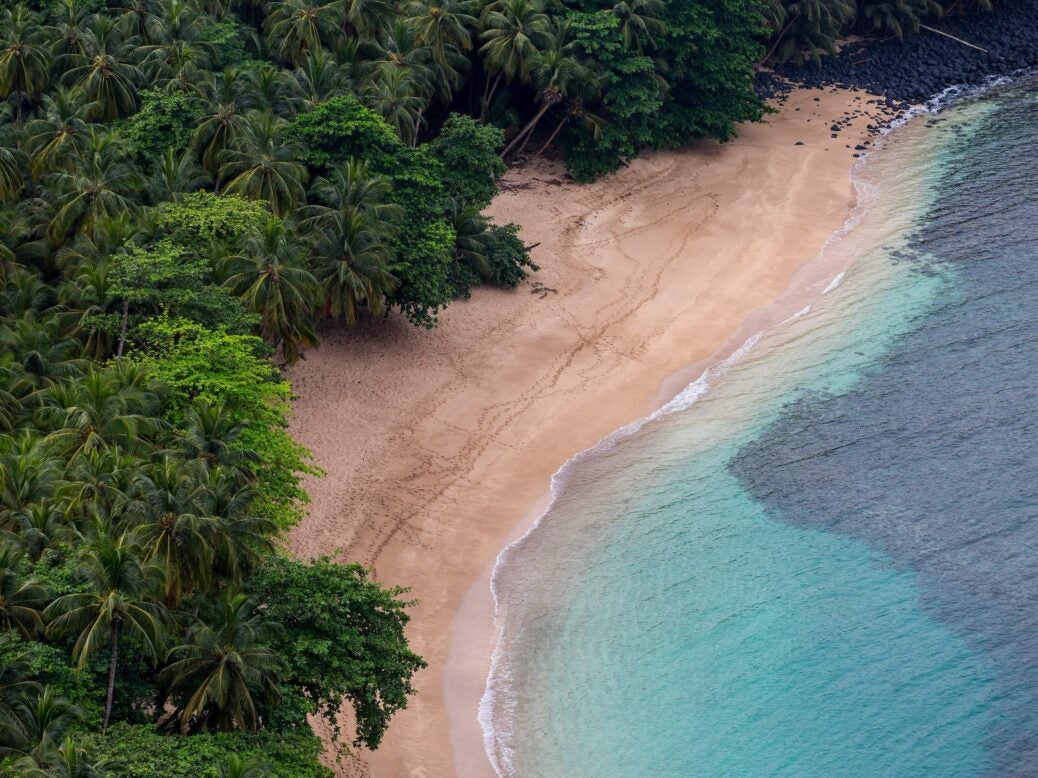
The island of Príncipe is a heavenly destination for us humans, as well as an ideal spot for rarer species, writes Stanley Johnson
We walked down to the beach – Praia Grande – through the forest with our guide, Ofreo. The sun was setting and the palm trees, which fringed the golden sand, caught its last rays.
‘What are the chances of seeing a turtle?’ I asked. ‘Look there!’ Ofreo pointed down the beach. ‘There’s one over there. She will have just laid her eggs.’ The turtle was already heading back to the sea. She propelled herself with her flippers across the sand, then entered the surf 20 yards from where we stood and disappeared from view beneath the waves.
Praia Grande is the most important turtle beach on Príncipe. The adult turtle we saw was a hawksbill, but the beach is also a nesting area for the leatherback turtle (the largest of all seven species of marine turtle – a mature adult can be two metres long) and, most importantly, the green turtle. Last year the Príncipe Foundation – a local conservation NGO – counted more than 2,000 green turtle nests.
‘How many eggs will a turtle lay in its nest?’ I asked. ‘Over 100,’ Ofreo replied. ‘And each turtle will come back to the beach three times to nest during the season.’
I have seen marine turtles in the wild before, both in the Galapagos in the Pacific and on Ascension Island in the South Atlantic. But the ‘turtle experience’ my wife Jenny and I had that evening on Praia Grande Beach on the tiny island of Príncipe, 200 miles off the west coast of Africa, was simply off the scale.
Marine turtles lay their eggs above the high-water mark. On Praia Grande, most of the nests are high up on the beach, shaded by the palm trees. By an extraordinary piece of luck, our arrival coincided with a sudden explosion of biological activity as scores of hatchlings clambered out of their nests and headed, with an unerring sense of direction, down the beach towards the ocean.
That evening we must have seen several hundred tiny turtles making tracks (literally) across the sand. As the hatchlings entered the water, to be borne out to sea by the surf and swell, we lost sight of them.
‘Twenty-five years from now,’ Ofreo told us, ‘those that survive will return to this very spot. The males will come to mate, the females to lay their eggs.’ ‘And how many of these hatchlings will survive?’ my wife asked. ‘Maybe one in a thousand.’
For me, that first evening on Praia Grande was undoubtedly the highlight of a blissful week. For a conservationist, this little island is a dream come true. The whole territory has been designated by Unesco as a World Biosphere Reserve. Príncipe’s forests shelter no fewer than eight endemic bird species, and it shares another three endemic species with neighbouring São Tomé. Jenny and I stayed at the magnificent Sundy Praia Lodge – the most luxurious ‘tented camp’ you could imagine. We were, literally, situated between the forest and the ocean.
There were times, at dawn and dusk, when the birdsong almost drowned the sound of the waves. If you are a ‘birder’, São Tomé and Príncipe is an absolute must. One afternoon, as my wife and I trekked through the forest with binoculars at the ready, we saw two of the seven endemics mentioned above – the Príncipe glossy starling, and the Príncipe golden weaver.
On another occasion, as we stood on the cliff high above the unbelievably scenic Banana Beach, we had a stirring view of the white-tailed tropicbirds whirling and swooping far below us.
Star quality
But you don’t have to be a naturalist to enjoy São Tomé and Príncipe. At Roça Sundy, an old plantation house set high up on the hill overlooking where we were staying, you can see the memorial to Arthur Eddington, the British astronomer who almost exactly 100 years ago (29 May 1919) took advantage of a solar eclipse and Príncipe’s equatorial location to ‘prove’ Einstein’s theory of relativity.
São Tomé was a key victualling station, supplying ships engaged in the slave trade well into the 19th century. Though you won’t find here many visible relics of that long and lamentable saga of man’s inhumanity to man, the sense of the past is nonetheless pervasive. There were no local inhabitants when these islands were discovered by the Portuguese at the end of the 15th century.
The population today – 7,000 on Príncipe, around 180,000 on the larger São Tomé – consists of a rich ethnic mix, many of them descendants of slaves or indentured workers employed in the sugar, coffee or cocoa plantations. Happily, the islands seem to have avoided the swamping monocultures that seem to have bedevilled so many other tropical islands. Nonetheless, the pressures on the remaining forests and on other natural resources are steadily increasing. South African entrepreneur Mark Shuttleworth is a man for whom the unique nature of the islands is proving to be a real inspiration.
He has made a series of major investments designed to build, in a genuinely sustainable way, on some of the islands’ unique characteristics. His portfolio of resorts includes the magnificent Sundy Praia, Roça Sundy and Bom Bom Resort, as well as Omali in São Tomé.
While backpackers, I am sure, will always be welcome, it is clear to me that within a very short space of time, São Tomé and Príncipe is going to be a destination of choice for the discerning traveller who, after a day in the forest with his or her binoculars, is ready to contemplate a seriously gastronomic dinner, inspired by the traditional local dishes and ingredients.
A couple of guitarists played while, on our last night in Príncipe, we ate our way through a seven-course meal accompanied by some fine Portuguese wines.
Far and Wild (https://farandwild.travel/; Tel: 01768 603 715) can offer a 7 night holiday to Sao Tome and Principe, combining 3 nights at Omali Lodge with 4 at Sundy Praia from £2,699 per person. The price is based on two sharing a one bedroom tented villa on half board basis and includes return international flights with TAP Air Portugal via Lisbon and internal flights between Sao Tome and Principe.
Stanley Johnson is a writer, environmentalist and former MEP











